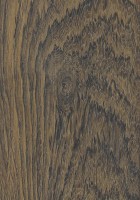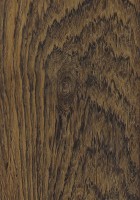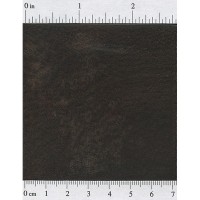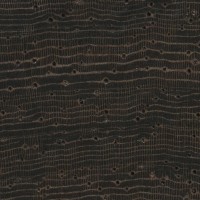 |
Common Name(s): Burmese Blackwood, Khamphi Rosewood, Laos Rosewood Scientific Name: Dalbergia cultrata Distribution: Southeast Asia Tree Size: 65-100 ft (20-30 m) tall, 1-1.6 ft (.3-.5 m) trunk diameter Average Dried Weight: 66 lbs/ft3 (1,060 kg/m3) Specific Gravity (Basic, 12% MC): .87, 1.06 Janka Hardness: 3,350 lbf (14,900 N) Modulus of Rupture: 11,450 lbf/in2 (78.9 MPa) Elastic Modulus: 1,600,000 lbf/in2 (11.03 GPa) Crushing Strength: 5,100 lbf/in2 (35.2 MPa) Shrinkage: Radial: 5.5%, Tangential: 9.2%, Volumetric: 14.7%, T/R Ratio: 1.7 |
Color/Appearance: Heartwood color is variable, and ranges from a medium olive or reddish brown to a darker purplish brown, frequently with nearly black streaks throughout. Color tends to darken with age. Pale gray sapwood is clearly demarcated from heartwood. With the light and dark streaks and lighter parenchyma bands, the wood can have a very unique (though subtle) grain pattern, particularly on flatsawn surfaces.
Grain/Texture: Grain can be irregular. With a uniform medium texture and very good natural luster.
Endgrain: Diffuse-porous; solitary and radial multiples; large pores in no specific arrangement, very few; dark brown gum deposits common; parenchyma vasicentric, and banded (sometimes in wide bands); narrow rays, spacing normal to fairly close.
Rot Resistance: No data available, though being a dense rosewood, it’s most likely very durable. Resistant to termites.
Workability: May be difficult to work on account of its density. Being in the Dalbergia genus, gluing precautions should be observed. Turns and finishes well, and able to take a high polish.
Odor: Mild scent not resembling most rosewoods in the Dalbergia genus.
Allergies/Toxicity: Although severe reactions are quite uncommon, rosewood in the Dalbergia genus has been reported as a sensitizer. Usually most common reactions simply include eye, skin, and respiratory irritation. See the articlesWood Allergies and Toxicity and Wood Dust Safety for more information.
Pricing/Availability: Occasionally imported as short and narrow boards, or turning stock. Prices are in the mid to upper range for an imported hardwood.
Sustainability: Burmese Blackwood is listed on CITES appendix II under the genus-wide restriction on all Dalbergia species—which also includes finished products made of the wood. It’s also reported by the IUCN as being near threatened. Technically it doesn’t meet the Red List criteria of a vulnerable or endangered species, but is close to qualifying and/or may qualify in the near future.
Common Uses: Turned objects, carvings, furniture, inlay, musical instruments (percussion), and small specialty wood items.
Comments: Called by a number of names, such as Khamphi Rosewood or Laos Rosewood, this species is actually in the true rosewood genus (Dalbergia), though another species, Dalbergia oliveri, is called Burmese Rosewood and has an overlapping distribution.
In addition to its unique coloration and grain patterning, Burmese Blackwood is also reputed to be very resonant, and is sometimes used for marimba bars and other musical instrument applications.
- African Blackwood (Dalbergia melanoxylon)
- Amazon Rosewood (Dalbergia spruceana)
- Bois de Rose (Dalbergia maritima)
- Brazilian Rosewood (Dalbergia nigra)
- Burmese Rosewood (Dalbergia oliveri)
- Cocobolo (Dalbergia retusa)
- East Indian Rosewood (Dalbergia latifolia)
- Honduran Rosewood (Dalbergia stevensonii)
- Kingwood (Dalbergia cearensis)
- Madagascar Rosewood (Dalbergia baronii)
- Siamese Rosewood (Dalbergia cochinchinensis)
- Sissoo (Dalbergia sissoo)
- Tulipwood (Dalbergia decipularis)
- Yucatan Rosewood (Dalbergia yucatensis)









Hi there, I have a wonderful guitar that is for sale, but I need to know the exact wood species to be able to ship it abroad (CITES regulation). Can you help me out? It looks like the sides are a rosewood species but the back? The guitar was built in Japan in 1976. Thanks a lot!
I’m not sure you’re going to be able to adequately ID such a guitar for CITES purposes. Perhaps someone with more experience in importing rosewood guitars can chime in.
The table i had made in 1967 was said to be of Siamese cedar
is that correct ? it is a very hard timber pale in colour evenly grained and shows little affect of its many years of use,
My builder at the time imported a log made our table his front door and other items we choose it as was said to be hard, and has proved so
We wax it
the picture named : Burmese Blackwood (turned), the white lines: WHAT IS THAT MATERIAL?
Those white lines are maple veneer.
Eric is being sarcastic. The white lines are made of Parenchyma. It’s related to pith, and has to do with moisture control. See from above article section titled “Grain:” the following line “…parenchyma vasicentric, and banded (sometimes in wide bands)…”. So those lines are the bands. Many woods with light marks in the grain have pronounced parenchyma. Usually it’s just around the pores, so it appears as flecks in the grain, but sometimes it forms wings on either side of the pore, so there will be streaks, and sometimes these group together to form clustered bands or waves, and in… Read more »
I was not being sarcastic. He asked particularly about the image of the turned object, which is a segmented vessel with Burmese blackwood as the body, but I used maple veneer as the spacers.
What is the differences between cultrata and lanceolaria? Seems hard to find Lumber data information for Burma Blackwood (lanceolaria).
I would like to know its work abilities ,availability and common dimensions,tone and cost?Really like the grain.If you know please reply.